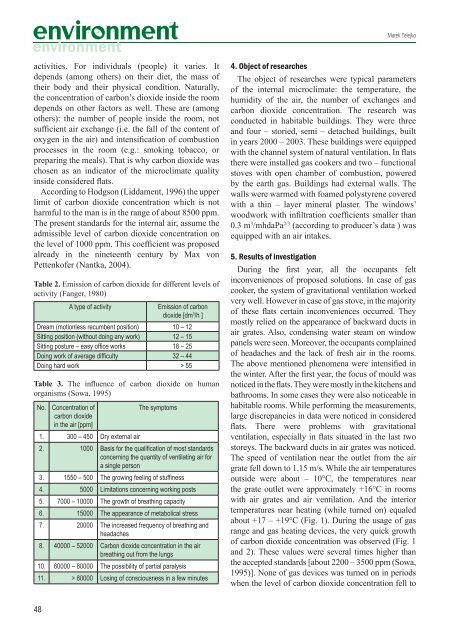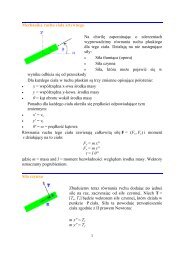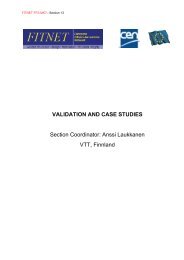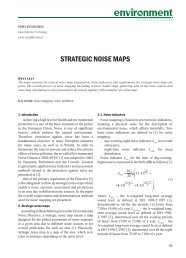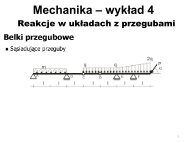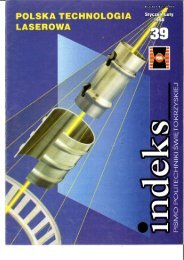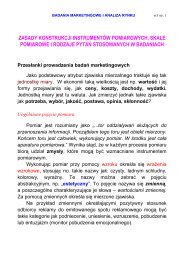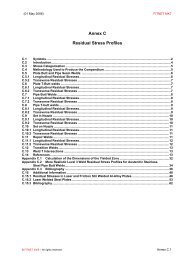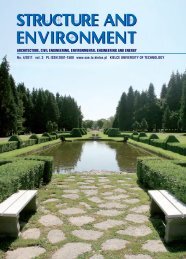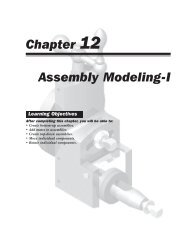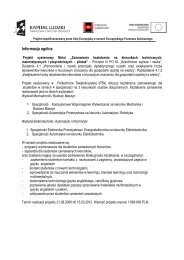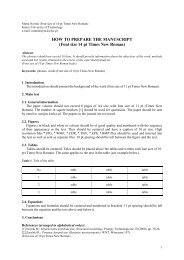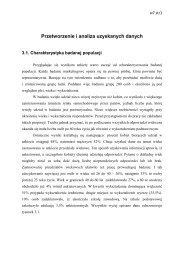Pobierz pełny numer 1/2010 S&E - Structure and Environment - Kielce
Pobierz pełny numer 1/2010 S&E - Structure and Environment - Kielce
Pobierz pełny numer 1/2010 S&E - Structure and Environment - Kielce
- No tags were found...
You also want an ePaper? Increase the reach of your titles
YUMPU automatically turns print PDFs into web optimized ePapers that Google loves.
Marek Telejkoactivities. For individuals (people) it varies. Itdepends (among others) on their diet, the mass oftheir body <strong>and</strong> their physical condition. Naturally,the concentration of carbon’s dioxide inside the roomdepends on other factors as well. These are (amongothers): the number of people inside the room, notsufficient air exchange (i.e. the fall of the content ofoxygen in the air) <strong>and</strong> intensification of combustionprocesses in the room (e.g.: smoking tobacco, orpreparing the meals). That is why carbon dioxide waschosen as an indicator of the microclimate qualityinside considered flats.According to Hodgson (Liddament, 1996) the upperlimit of carbon dioxide concentration which is notharmful to the man is in the range of about 8500 ppm.The present st<strong>and</strong>ards for the internal air, assume theadmissible level of carbon dioxide concentration onthe level of 1000 ppm. This coefficient was proposedalready in the nineteenth century by Max vonPettenkofer (Nantka, 2004).Table 2. Emission of carbon dioxide for different levels ofactivity (Fanger, 1980)A type of activityEmission of carbondioxide [dm 3 /h ]Dream (motionless recumbent position) 10 – 12Sitting position (without doing any work) 12 – 15Sitting posture – easy office works 18 – 25Doing work of average difficulty 32 – 44Doing hard work > 55Table 3. The influence of carbon dioxide on humanorganisms (Sowa, 1995)No. Concentration ofThe symptomscarbon dioxidein the air [ppm]1. 300 – 450 Dry external air2. 1000 Basis for the qualification of most st<strong>and</strong>ardsconcerning the quantity of ventilating air fora single person3. 1550 – 500 The growing feeling of stuffiness4. 5000 Limitations concerning working posts5. 7000 – 10000 The growth of breathing capacity6. 15000 The appearance of metabolical stress7. 20000 The increased frequency of breathing <strong>and</strong>headaches8. 40000 – 52000 Carbon dioxide concentration in the airbreathing out from the lungs10. 60000 – 80000 The possibility of partial paralysis11. > 80000 Losing of consciousness in a few minutes4. Object of researchesThe object of researches were typical parametersof the internal microclimate: the temperature, thehumidity of the air, the number of exchanges <strong>and</strong>carbon dioxide concentration. The research wasconducted in habitable buildings. They were three<strong>and</strong> four – storied, semi – detached buildings, builtin years 2000 – 2003. These buildings were equippedwith the channel system of natural ventilation. In flatsthere were installed gas cookers <strong>and</strong> two – functionalstoves with open chamber of combustion, poweredby the earth gas. Buildings had external walls. Thewalls were warmed with foamed polystyrene coveredwith a thin – layer mineral plaster. The windows’woodwork with infiltration coefficients smaller than0.3 m 3 /mhdaPa 2/3 (according to producer’s data ) wasequipped with an air intakes.5. Results of investigationDuring the first year, all the occupants feltinconveniences of proposed solutions. In case of gascooker, the system of gravitational ventilation workedvery well. However in case of gas stove, in the majorityof these flats certain inconveniences occurred. Theymostly relied on the appearance of backward ducts inair grates. Also, condensing water steam on windowpanels were seen. Moreover, the occupants complainedof headaches <strong>and</strong> the lack of fresh air in the rooms.The above mentioned phenomena were intensified inthe winter. After the first year, the focus of mould wasnoticed in the flats. They were mostly in the kitchens <strong>and</strong>bathrooms. In some cases they were also noticeable inhabitable rooms. While performing the measurements,large discrepancies in data were noticed in consideredflats. There were problems with gravitationalventilation, especially in flats situated in the last twostoreys. The backward ducts in air grates was noticed.The speed of ventilation near the outlet from the airgrate fell down to 1.15 m/s. While the air temperaturesoutside were about – 10°C, the temperatures nearthe grate outlet were approximately +16°C in roomswith air grates <strong>and</strong> air ventilation. And the interiortemperatures near heating (while turned on) equaledabout +17 – +19°C (Fig. 1). During the usage of gasrange <strong>and</strong> gas heating devices, the very quick growthof carbon dioxide concentration was observed (Fig. 1<strong>and</strong> 2). These values were several times higher thanthe accepted st<strong>and</strong>ards [about 2200 – 3500 ppm (Sowa,1995)]. None of gas devices was turned on in periodswhen the level of carbon dioxide concentration fell to48


